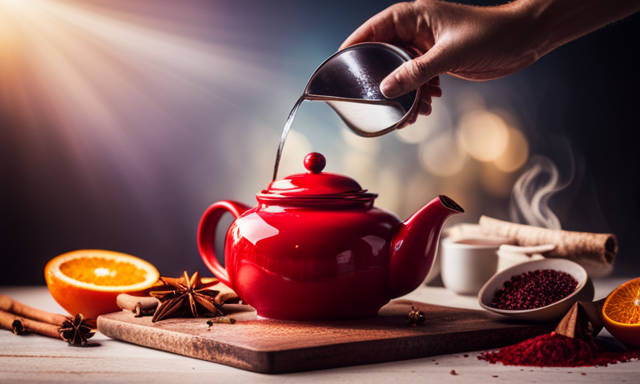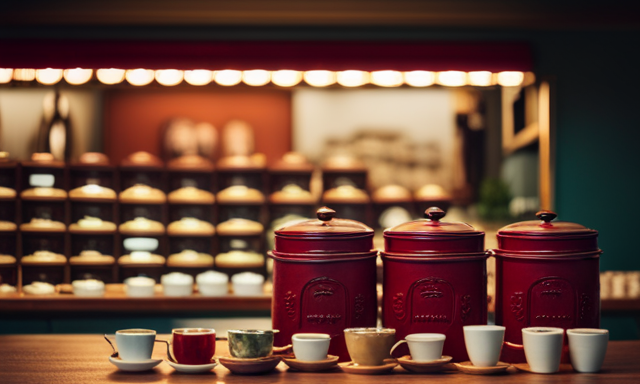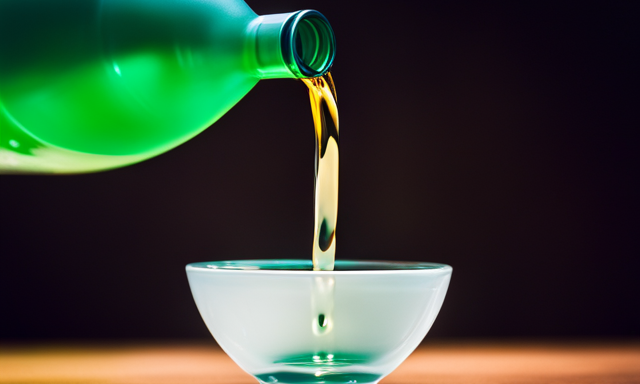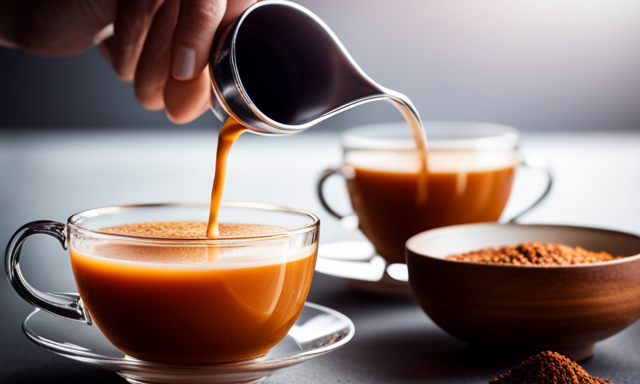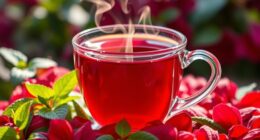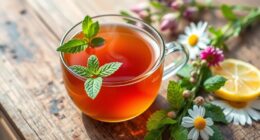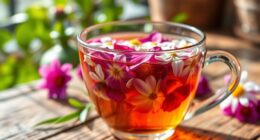Step into the world of aromatic indulgence as I guide you through the art of brewing flavor-infused rooibos tea. Picture yourself in a cozy kitchen, the air filled with the comforting scent of freshly steeped tea leaves. With this simple yet delightful process, you’ll learn how to create a cup of rooibos tea bursting with flavor and character.
First, we’ll uncover the origins of this exquisite tea, tracing its roots back to the sun-kissed lands of South Africa. Then, armed with the knowledge of selecting high-quality rooibos leaves, we’ll embark on the journey of brewing the perfect cup. Boiling fresh water becomes a crucial step, ensuring that every sip is infused with the full-bodied essence of the tea.
Next, we’ll measure the ideal amount of rooibos tea and allow it to steep for just the right amount of time, unlocking its rich flavors. Once strained, you’ll be ready to savor this delightful elixir.
And for those seeking a touch of creativity, we’ll explore the world of flavor additions, allowing you to customize your rooibos tea experience.
Finally, I’ll teach you how to properly store your rooibos tea for future enjoyment.
Are you ready to embark on this aromatic adventure? Let’s begin!
Key Takeaways
- Experiment with different flavors and additions to customize rooibos tea
- Add sweetness with honey or maple syrup, or create a refreshing twist with citrus fruits
- Enhance warmth with spices like cinnamon, ginger, or cardamom
- Properly store rooibos tea in a cool, dark, and airtight container to retain freshness and flavor
Understand the Origins of Rooibos Tea
The origins of rooibos tea can be traced back to the beautiful Cederberg region of South Africa.
Exploring the health benefits of rooibos tea, it is known for its rich antioxidant properties that can help boost the immune system and promote overall well-being.
Not only is rooibos tea a delicious and refreshing drink, but it also holds great cultural significance for the people of South Africa. For centuries, it has been used as a traditional remedy for various ailments and is deeply rooted in local customs and traditions.
To make the perfect cup of rooibos tea, it is essential to choose high-quality rooibos leaves that have been carefully harvested and processed. These leaves will ensure that you experience the full flavor and benefits of this unique and invigorating beverage.
Choose High-Quality Rooibos Leaves
To experience the ultimate satisfaction in your cup, nothing beats selecting the absolute finest rooibos leaves available. When choosing organic rooibos, you can be confident that you are getting a product free from pesticides and other harmful chemicals. Organic rooibos is also known for its superior flavor and aroma, making it the perfect choice for brewing a delicious cup of tea.
Not only does rooibos tea taste great, but it also offers numerous health benefits. Rich in antioxidants, this tea can help boost your immune system and protect against oxidative stress. It is also caffeine-free, making it a great option for those looking to reduce their caffeine intake.
Now that you have chosen your high-quality rooibos leaves, it’s time to move on to the next step – boiling fresh water.
Boil Fresh Water
Now, imagine the sound of bubbling water as you bring fresh water to a boil, filling your kitchen with the anticipation of a perfectly steeped cup of tea.
When it comes to brewing rooibos tea, using filtered water is essential. Filtered water removes impurities that can alter the taste and aroma of the tea. The quality of the water directly affects the flavor profile of the tea, so it’s worth investing in a good filtration system.
Additionally, the temperature of the water plays a crucial role in extracting the optimal flavors from the tea leaves. Rooibos tea requires a water temperature of around 200°F (93°C) to bring out its rich and earthy flavors.
Now that we understand the importance of water, let’s move on to the next step: measuring the right amount of rooibos tea.
Measure the Right Amount of Rooibos Tea
Imagine yourself standing in your kitchen, holding a small scoop filled with the perfect amount of aromatic rooibos leaves, ready to infuse their goodness into your cup of hot water.
To brew flavorful rooibos tea, it is crucial to measure the right amount of tea leaves. This step ensures that you achieve the ideal balance of flavor and health benefits.
Measuring techniques may vary, but a general rule of thumb is to use one teaspoon of loose rooibos tea per cup of water. However, feel free to adjust the amount according to your personal taste preference.
Rooibos tea is known for its numerous health benefits, including its antioxidant properties and ability to promote relaxation.
So, go ahead and measure the perfect amount of rooibos tea, and get ready to steep it for the perfect amount of time to unlock its full potential.
Steep the Tea for the Perfect Amount of Time
Steeping the tea for the perfect amount of time allows the flavors to fully infuse and create a delightful cuppa, but how long is too long?
When it comes to rooibos tea, steeping for a longer duration can actually enhance its flavor and offer additional benefits. The longer steeping time allows the natural sweetness and earthy notes of the tea to develop, resulting in a richer and more robust taste.
However, it is important to consider the factors that can affect the perfect steeping time for different types of tea. Factors such as the type of tea leaves, water temperature, and personal preference all play a role in determining the ideal steeping time.
Experimenting with different time intervals will help you find the perfect balance that suits your taste.
Now, let’s move on to the next step: adding sweeteners or enhancements (optional).
Add Sweeteners or Enhancements (Optional)
After steeping the rooibos tea for the perfect amount of time, it’s time to add some optional sweeteners or enhancements to further elevate the flavor profile. While rooibos tea is naturally sweet and flavorful on its own, adding a touch of sweetness can enhance the overall experience. Some popular sweeteners for rooibos tea include honey, agave nectar, or stevia. These natural alternatives not only add sweetness but also offer additional health benefits. Rooibos tea is known for its antioxidant properties and its ability to boost the immune system. By infusing it with natural sweeteners, you can create a delicious and healthy beverage that satisfies both your taste buds and your body. Now that we’ve enhanced the flavor, it’s time to strain the tea to ensure a smooth and enjoyable drinking experience.
Strain the Tea
To fully savor the aromatic infusion, it’s time to strain the brewed tea for a smooth and delightful sipping experience. Proper straining techniques are crucial in ensuring that no loose tea leaves or debris end up in your cup.
One popular method is to use a fine mesh strainer. This type of strainer effectively catches even the smallest particles, resulting in a clean and clear tea.
Alternatively, you can also use a tea infuser with fine holes that prevent the tea leaves from escaping. Some tea enthusiasts prefer using a tea sock or a cheesecloth for straining, as they allow for a more thorough extraction of flavors.
Whichever method you choose, make sure to strain the tea directly into your teacup or teapot.
Now that your tea is perfectly strained, it’s time to serve and enjoy the refreshing flavors of your rooibos tea!
Serve and Enjoy!
After straining the tea and removing any remaining leaves, it’s time to serve and enjoy your perfectly brewed rooibos tea. I like to pour it into a beautiful teacup, admiring its vibrant color and enticing aroma. The first sip is always a delight, as the smooth and rich flavor of rooibos envelops my taste buds.
Rooibos tea is incredibly versatile and pairs well with a variety of foods. For a light and refreshing pairing, I recommend serving it with a fresh fruit salad or a slice of lemon cake. If you prefer something more savory, try enjoying it with a cheese and crackers platter or a bowl of roasted nuts.
In addition to its delicious taste, rooibos tea also offers numerous health benefits. It is packed with antioxidants that can help boost your immune system and promote overall well-being. It is also naturally caffeine-free, making it a great choice for those looking for a caffeine alternative.
Now that you’ve learned how to brew and enjoy a flavorful cup of rooibos tea, let’s move on to the next section and experiment with different flavors and additions.
Experiment with Different Flavors and Additions
Indulge your palate and elevate your tea experience by exploring an array of delightful and unexpected combinations that will tantalize your taste buds. Experimenting with different flavor combinations is a wonderful way to customize your rooibos tea and discover your own unique blend. You can add a touch of sweetness with ingredients like honey or maple syrup, or create a refreshing twist with citrus fruits like lemon or orange. For a warming and cozy cup, try adding spices like cinnamon, ginger, or cardamom. The benefits of adding herbs and spices extend beyond just flavor enhancement. They can also provide added health benefits such as digestion aid or immune support. With endless possibilities, let your creativity flow and find your perfect cup of rooibos tea. Now let’s explore how to store rooibos tea properly for future use.
Store Rooibos Tea Properly for Future Use
After experimenting with different flavors and additions to enhance the taste of my rooibos tea, I have learned the importance of properly storing it for future use. Proper storage techniques are crucial for ensuring the long term preservation of this delightful brew.
When it comes to rooibos tea, it is essential to keep it away from moisture, light, and strong odors. To achieve this, I recommend storing it in an airtight container, such as a glass jar with a tight-fitting lid, in a cool and dark place, like a pantry or cupboard.
This will help retain its freshness and prevent any unwanted flavor changes. By following these storage guidelines, I can continue to enjoy the rich and flavorful experience of rooibos tea for a long time to come.
Frequently Asked Questions
Can I use tap water instead of fresh water to brew rooibos tea?
Using tap water for brewing rooibos tea is like adding a splash of dullness to a vibrant masterpiece. While it’s convenient, tap water may contain impurities that affect the flavor. Consider using fresh, filtered water for a more exquisite brew.
How can I tell if the rooibos leaves are of high quality?
To choose high quality rooibos leaves, look for vibrant red color and finely cut leaves. They should have a sweet and earthy aroma. Drinking rooibos tea offers numerous benefits, such as improved digestion and a boost to the immune system.
Is it necessary to strain the tea after brewing?
Yes, it is absolutely crucial to strain the tea after brewing! Not only does it remove any lingering leaves, but it also ensures a smooth and delicious cup. Plus, straining helps maximize the health benefits of rooibos tea.
Can I reuse the rooibos leaves for a second steeping?
Yes, you can reuse rooibos leaves for a second steeping. It’s a great way to maximize the flavor and benefits of the tea. The second steeping can still be delicious and offer a slightly milder taste.
What are some popular flavor combinations to enhance rooibos tea?
To enhance the taste of rooibos tea, popular flavor combinations include vanilla and honey for a sweet and creamy twist, or citrus fruits like orange and lemon for a refreshing and tangy flavor profile.
Conclusion
In conclusion, brewing a flavorful cup of rooibos tea is a delightful and rewarding experience. As I sip the warm infusion, the earthy aroma and rich taste transport me to the vast, sun-kissed plains of South Africa where this remarkable tea originates.
The careful selection of high-quality leaves, precise measurement, and perfect steeping time ensure a tantalizing cup every time.
With a touch of creativity, I can explore a myriad of flavors and additions to enhance my tea-drinking pleasure.
By storing the tea properly, I can continue to enjoy this exquisite brew for many more moments of pure indulgence.

